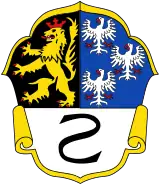Ƨ
Ƨ (minuscule: ƨ) is a letter of the Latin alphabet; depending on the context in which the letter is used, it is based on the numeral 2 or the Latin letter S.
Ƨ was used in the Zhuang alphabet from 1957 to 1986 to indicate the second, or falling, tone (IPA: [˧˩]), due to its resemblance to the numeral 2, along with four other letters resembling numbers. (See: Table). In 1986, Ƨ was replaced by the similarly shaped, but fully Latin, Z, when the alphabet was simplified for use in computers.
As a reversed S, Ƨ was also used as a fractional Roman numeral, where it stood for the fraction 1⁄72.
The proposed Metelko alphabet, devised by Franc Serafin Metelko, used the letter Ƨ to represent the schwa ə sound; it is unclear what inspiration Metelko used for the character (possibly from the Georgian letter ჷ used in the Laz and Svan languages spoken in the Southern Caucasus).
In italic type, ⟨г⟩ Cyrillic's ge ⟨г⟩ is strongly homoglyphic to the lowercase ƨ. Early forms of the letter dze ⟨S⟩, currently only used in Macedonian Cyrillic, could resemble either a forward or reversed S.

A charge strongly resembling a Ƨ appears in the civic coat of arms borne by the municipality of Haßloch in Rhineland-Palatinate, Germany.
Reversed S is very often used in languages using the Latin alphabet as a substitute for S, to simulate a young child's handwriting.
Computing codes
| character | Ƨ | ƨ | ||
| Unicode name | Latin capital letter Tone Two | Latin small letter Tone Two | ||
| character encoding | decimal | hex | decimal | hex |
| Unicode | 423 | 01A7 | 424 | 01A8 |
| UTF-8 | 198 167 | C6 A7 | 198 168 | C6 A8 |
| Numeric character reference | Ƨ | Ƨ | ƨ | ƨ |
The Unicode name of the letter is "tone two," but is encoded in an order that suggests it is a form of the letter S, between the Latin letters Yr (Ʀ) and capital Esh (Ʃ).